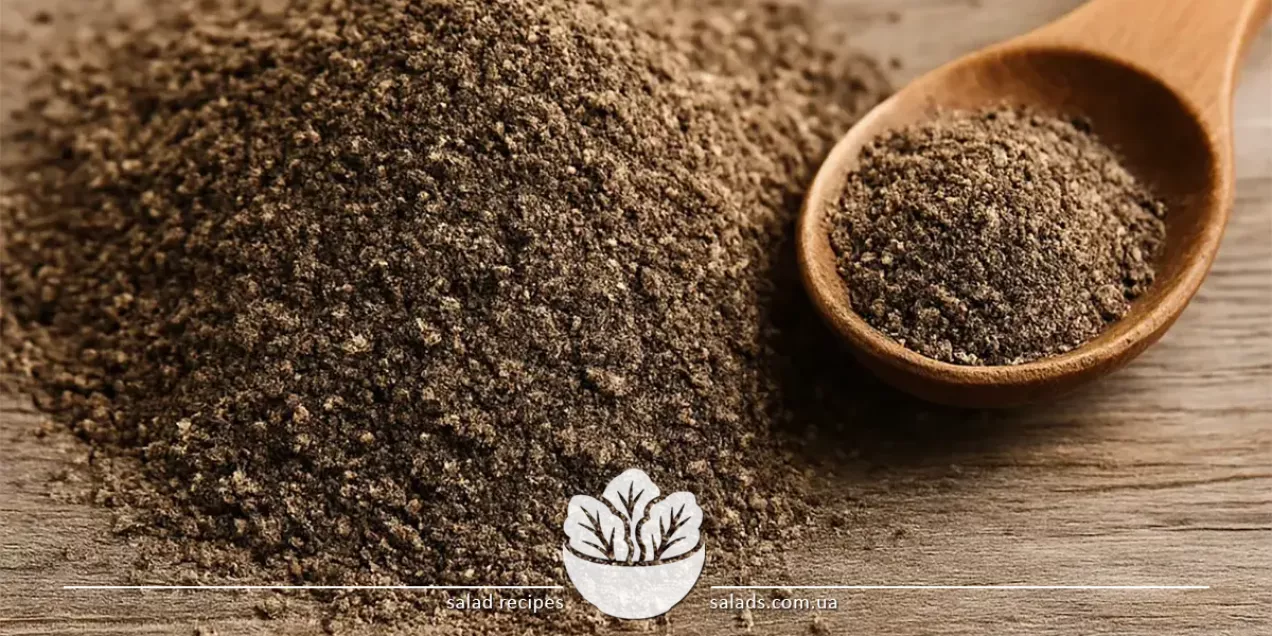
Ground Black Pepper

Ground black pepper is one of the essential spices in any kitchen, used to enhance the flavor of a wide variety of dishes. Due to its high content of essential oils, this product offers a pronounced aroma and moderate heat that remains even after cooking. It is added to soups, meat, vegetables, eggs, sauces, and salads, as well as to marinades for preservation. This type of seasoning is produced by grinding dried black peppercorns. You can learn more about other types of pepper in the corresponding section.
Salad Recipes with Ground Black Pepper
Aroma and Flavor of Ground Black Pepper
Ground black pepper is characterized by a rich aroma with woody and spicy notes, mild bitterness, and delicate heat. Its flavor profile is formed by essential oils contained in the outer layer of the peppercorns. After grinding, some of the oils evaporate, but when stored properly, the spice retains its properties for a long time. For this reason, ground pepper not only enhances the taste of dishes but also adds expressiveness without requiring additional seasonings. In food, pepper acts as a natural flavor enhancer. It activates the taste receptors, revealing deeper tones of the base ingredients – meat, vegetables, grains, or legumes. In soups and sauces, it creates a spiced foundation, while in salads and marinades, it adds heat without dominating. Thanks to these qualities, ground black pepper is versatile and fits into any cuisine – from everyday Ukrainian dishes to exotic combinations. It especially shines in meat dishes – for example, it pairs perfectly with minced beef, giving homemade cutlets or meatballs a richer taste and a subtle spicy aroma.
Production Technology of Ground Black Pepper
Ground black pepper is made by grinding the dried fruits of the Piper nigrum plant. The pepper berries are harvested in a semi-ripe state – when they are still green but beginning to turn red. After harvesting, the berries are dried in the sun or in special dryers until completely dehydrated. During the drying process, the fruits darken and shrivel, acquiring the characteristic black color and concentrated aroma. Different degrees of grinding – from coarse to powder-like – are used depending on the intended application. In industrial settings, pepper is ground just before packaging to preserve as much of the essential oils as possible. At home, it’s best to grind pepper right before use to ensure maximum aromatic intensity. The quality of ground pepper depends not only on the variety and place of cultivation but also on the method of processing. For example, premium pepper dried naturally has a more complex and vibrant aroma, while finely ground pepper without hull fragments is better suited for sauces and soups. In preparing first courses, it is often combined with ingredients that have a mild, rounded flavor – such as green lentils, which provide a balance between spice and the base component of the dish.
Use in Everyday Cooking
Ground black pepper is one of the most commonly used spices in home cooking. It is added to almost every dish – soups, main courses, side dishes, appetizers, marinades, and even some desserts. In soups and borscht, it adds a light heat; in meat and poultry, it enhances the natural taste; and in salads, it balances fat and acidity. The most classic use is seasoning prepared dishes right before serving, which helps preserve the maximum intensity of aroma. Due to its moderate pungency and versatility, ground pepper doesn't require complex combinations. It’s added to vegetable dishes, casseroles, scrambled eggs, grains, and even sauces based on sour cream, cream, or tomatoes. In national cuisines, it’s used in dishes ranging from dumplings and cabbage rolls to pasta and grilled foods. Ground pepper works especially well with vegetables that have a sweet or neutral flavor. For example, in stews with white cabbage, it adds depth and spiciness without overwhelming the main aroma, only enhancing it.
Pairing with Other Spices and Ingredients
Ground black pepper pairs wonderfully with most other spices, creating balanced aromatic blends. It harmonizes well with bay leaves, dried garlic, paprika, coriander, marjoram, and nutmeg. Thanks to its versatility, pepper is a base for many classic mixes – such as herbes de Provence, five-spice blends, or complex marinades for meat and fish. It also pairs well with acidic, sweet, and creamy ingredients. In dishes with cream or sour cream sauces, ground pepper softens the richness and adds a refined contrast. In salads with acidic dressings, it balances the acidity and enhances the core ingredients. In vegetable dishes, it adds depth without excessive heat. It works best in complex dishes that include multiple flavor layers. For instance, in stewed vegetables or sauces that include ingredients like sautéed onion, which adds a sweet, caramel-like depth. Together with the pepper, it creates a rich, balanced flavor that needs no extra seasoning.
Storage and Home Use
To preserve the aroma and quality of ground black pepper, it’s important to store it properly. The best option is a tightly sealed glass jar or a special container with an airtight lid. The spice should be kept in a dry, dark place away from direct sunlight, heat, and moisture. Under such conditions, pepper retains its aromatic intensity for up to 12 months, although essential oils gradually evaporate over time. In home cooking, ground black pepper is used both during the cooking process and immediately before serving. In the first case, it distributes evenly in the dish, and in the second – it forms a strong aromatic note on the surface. It's important not to exceed the recommended amount: too much pepper can overpower the flavor of the main ingredients, especially in light vegetable or dairy-based dishes. For marinades and homemade preserves, ground pepper is often combined with ingredients like mustard. This blend adds depth and spiciness to sauces and marinades, allowing the full flavor of meat, fish, or vegetables to unfold.










